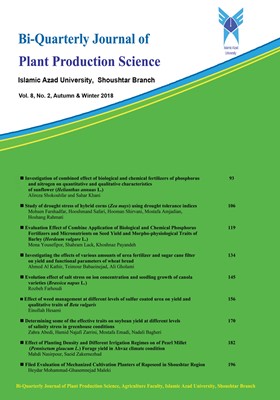Determining some of the effective traits on soybean yield at different levels of salinity stress in greenhouse conditions
Subject Areas : agronomyzahra Abedi 1 , Hamid Najafi Zarrini 2 , Mostafa Emadi 3 , Nadali Bagheri 4
1 - 1- PhD Student in Plant Breeding, Sari Agricultural Sciences and Natural Resources University, Sari, Iran
2 - 2- Assistant Prof., Department of Plant Breeding and Biotechnology, Sari Agricultural Sciences and Natural Resources University, Sari, IRAN
3 - 3- Assistant Prof., Department of Soil Science, Sari Agricultural Sciences and Natural Resources University, Sari, IRAN
4 - 2- Assistant Prof., Department of Plant Breeding and Biotechnology, Sari Agricultural Sciences and Natural Resources University, Sari, IRAN
Keywords: Path analysis, Correlation Coefficient, oil percentage, Keywords: Regression analysis,
Abstract :
Salinity is one of the growth limiting factors in agricultural. In order to determination of the most effective traits on soybean yield at different levels of salinity stress, a factorial experiment with 3 replications was conducted in greenhouse of Sari Agricultural Sciences and Natural Resources University in 2016. Treatments consisted of four soybean genotypes (Hill, Dayr, Ford and Williams), three levels of sulfur (control, 5 and 10 grams of sulfur powder) and three levels of salinity (control, 4 and 8 dS/m). Analysis of variance showed that simple effects of sulfur, genotype, salinity and interaction between sulfur and salinity were significant at 0.01 probability level. Correlation coefficients between studied traits showed that there was a positive and significant correlation between grain yield and all traits except for the Na+/K+ ratio. By using stepwise regression analysis in the control treatment, sulfur content, in 4 ds/m salinity, traits of Na+ percentage, fresh weight of shoot and seed protein percentage, and in salinity of 8 ds/m seed number per plant were entered in model. path analysis of grain yield showed the highest positive direct effect in the control, second level and the third level of salinity were sulfur content, Na+ and number of seeds per plant, respectively. The results of this study showed that the traits of sulfur content, Na+ percentage, fresh weight and protein percentage are the scales related to grain yield, which can be used as an indirect selection scale for genetic improvement of yield in saline regeneration programs.
_||_


